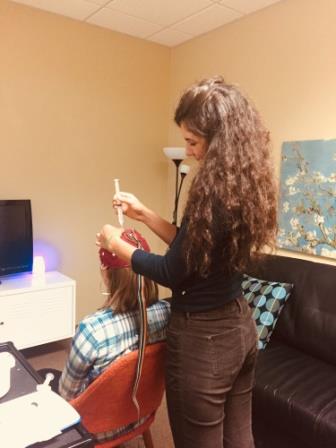 Q-Day Q and A
Q-Day Q and A
Let a Tech Answer Your Q-Day Questions
Client: So what is Q-Day?
Tech: Q-Days are one morning every week when we have our medical director on site and are able to run “Qs” which is tech-speak for quantitative Electroencephalograph, or qEEG. Clients receiving a Q will meet with our medical director, Dr. Lisa Murdoch, to go over any symptoms and concerns, fill out a Cognitive Emotional Checklist (CEC), and get their Q. It normally takes about an hour.
Client: What is a Quantitative Elector-E-What-O-Gram?
Tech: That’s why we just call them Qs! Are you familiar with ECGs which measure the electric signals of your heart? qEEGs are able to do the same thing but instead measures the electrical impulses at 19 sites of your brain. From those recordings we are able to construct a brain map, which shows the amount of each kind of wave throughout your brain. It kinda looks like a seismograph or a polygraph read out.
Client: What do you mean, electricity in my brain? You won’t shock me will you?
Tech: No, of course not! We are just recording the natural electricity. Neurons, the specialized conductive cells that make up your brain, send signals through electrical impulses. These electrical waves are what we refer to as brain waves. And, just like there are lots of different radio waves, each correlated with a different radio station, there is a whole spectrum of brain waves that are associated with different types of cognitive functions. All the Q is doing is recording the activity of each type of wave across your brain. In order to get the recordings we put on a hat with 19 electrodes, fill each of those sites with conductive gel, tell some bad jokes, make sure we have great connections, and then have you sit still and relaxed for 20 minutes while we record your brain waves on a computer.
Client: Why is it important to be still and relaxed?
Tech: Like any medical test we want the results to be as accurate as possible. Any muscle tension in your face, jaw, or neck will cause artifacts, or inaccurate readings. Movements, even the smallest moves of your eyes, can also provide faulty data. Of course we know it is impossible to be perfectly still for 20 mins. You’re certainly able to blink, swallow, and momentarily scratch. Just know that the less you do the better the results. Easiest test ever right? Just sit and quite literally do nothing!
Client: Ok, and what will this information be able to tell you?
Tech: Ideally brains should be able to switch to the appropriate type of brainwave based on the task at hand. Certain waves are associated with certain functions. For example Delta waves are necessary for sleep and relaxation, while Beta waves are required for high focus and concentration. When brains are operating with abundances or deficiencies of certain waves it may be difficult to perform certain tasks. Certain patterns in brain waves have also been associated with certain mental health issues.
Client: What happens after I get a Q and you make a brain map?
Tech: Your brain map with help provide Jan Matney, our nCenter Director, the necessary information to design a neurofeedback protocol for you! This protocol is constructed based on the information you provided Dr. Murdoch and the results of your brain map. Jan can make all sorts of adjustments to your protocol to tailor it directly to you. How the protocols are decided is a little over the training for us techs– but make sure you are discussing your progress, symptoms, and goals with us and Jan. She can alter your protocol based on this information to ensure you get the best results from neurofeedback!
Photo: nCenter Tech giving a brain map to client. Photo by Kaitlin Helminski

